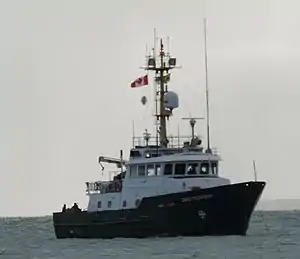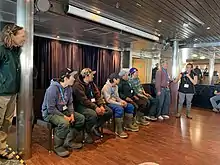Wrecks of HMS Erebus and HMS Terror National Historic Site
The Wrecks of HMS Erebus and HMS Terror National Historic Site is a National Historic Site of Canada near King William Island in Nunavut, Canada. It protects the wrecks of HMS Erebus and HMS Terror, the two ships of the last expedition of Sir John Franklin, lost during their search for the Northwest Passage. The site is jointly managed by Parks Canada and the local Inuit people. Public access to the site is not permitted.[1]
History

On 7 September 2014 the wreck of HMS Erebus was discovered by the Canadian Victoria Strait expedition in Wilmot and Crampton Bay, to the west of the Adelaide Peninsula just to the south of King William Island.[2] On 12 September 2016, the wreck of HMS Terror was discovered by the Arctic Research Foundation in Terror Bay, off the southwest coast of King William Island.
Geography
The site consists of two separate areas, one enclosing each wreck, with perimeter coordinates:[3]
Archeology
%252C_2019.jpg.webp)
As at 2019, the wrecks are the subject of archeological research undertaken by Parks Canada using the RV David Thompson as living accommodation and a barge "Qiniqtiryuaq" to support the diving onto the wrecks and the documentation and conservation of artefacts removed from the wrecks.[4]
Ownership
Under international maritime law, as Royal Navy ships, the wrecked ships are the property of the United Kingdom. However, in 1997 before either wreck was discovered but in the belief that the wrecks must be within Canadian waters, the United Kingdom had entered into a non-binding Memorandum of Understanding with Canada that Canada could own the wrecks. In 1999, Canada created the new territory of Nunavut as part of the Nunavut Land Claims Agreement with the Inuit people and as part of that agreement gave the Inuit people the ownership of archaeological sites and artifacts within Nunavut's boundaries.[5]
After the wrecks were discovered, there was greater need to clarify all parties' rights in relation to the wrecks. In April 2019, the United Kingdom and Canada formally agreed that the original 65 artefacts removed from the wrecks would belong to the United Kingdom, but that the wrecks themselves and further artefacts removed would belong to Canada and the Inuit Heritage Trust with the exception of gold which would belong to the United Kingdom and any human remains would be repatriated to the United Kingdom.[6] In return Canada would not seek payment from the United Kingdom for their costs incurred in discovering the wrecks and in removing and conserving the artefacts.[7] In relation to the Inuit rights, the Canadian Government (represented by Parks Canada) and the Kitikmeot Inuit Association are currently negotiating an agreement that will establish a visitor centre at Gjoa Haven as an extension of the existing Nattilik Heritage Centre.[8][9]
Public access

Public access to the site is not allowed with the exception of Inuit people who are permitted to hunt and fish within the protected area.[3][10] To protect the site from the public, Inuit people from Gjoa Haven work as guardians, camping near the wreck sites to monitor access to the sites.[11]
However, on 5 September 2019, passengers of Adventure Canada on MS Ocean Endeavour were permitted to visit the site of the wreck of HMS Erebus as part of a trial by Parks Canada in creating a visitor experience for the wreck site.[12]
References
| Wikimedia Commons has media related to Wrecks of HMS Erebus and HMS Terror National Historic Site. |
- "Wrecks of HMS Erebus and HMS Terror National Historic Site". Parks Canada. 6 June 2019. Archived from the original on 8 October 2019. Retrieved 8 October 2019.
- Davison, Janet (27 September 2015). "Franklin expedition: New photos of HMS Erebus artifacts, but still no sign of HMS Terror". CBC News. Archived from the original on 26 November 2015. Retrieved 19 December 2015.
A big clue in the mystery is the wreck of HMS Erebus, found last year in a location indicated by Inuit oral histories.
- "Superintendent's order". Wrecks of HMS Erebus and HMS Terror National Historic Site. Parks Canada. 27 May 2019. Archived from the original on 8 October 2019. Retrieved 8 October 2019.
- "Underwater archaeology at the Franklin wrecks". Wrecks of HMS Erebus and HMS Terror National Historic Site. Parks Canada. Archived from the original on 8 October 2019. Retrieved 8 October 2019.
- Craciun, Adriana (14 July 2017). "Of shipwrecks and sovereignty". Ottawa Citizen. Retrieved 13 October 2019.
- Ducharme, Steve (24 October 2017). "HMS Erebus ship's bell recovered from Franklin expedition". Nunatsiaq News.
- Harris, Kathleen (26 April 2018). "Canada, Britain formalize agreement on Franklin expedition wrecks". CBC News. Archived from the original on 13 October 2019. Retrieved 13 October 2019.
- DeGeorge, Krestia (18 October 2018). "Inuit, Parks Canada close to deal on Franklin wrecks national historic site". Arctic Today. Archived from the original on 13 October 2019. Retrieved 13 October 2019.
- George, Jane (18 October 2018). "Inuit, Parks Canada close to deal on Franklin wrecks national historic site". Arctic Today. Archived from the original on 13 October 2019. Retrieved 13 October 2019.
- Parks Canada Agency, Government of Canada (6 June 2019). "Wrecks of HMS Erebus and HMS Terror National Historic Site". www.pc.gc.ca. Archived from the original on 4 September 2019. Retrieved 4 October 2019.
- "Inuit guardians program". Wrecks of HMS Erebus and HMS Terror National Historic Site. Parks Canada. 27 May 2019. Archived from the original on 8 October 2019. Retrieved 8 October 2019.
- Bain, Jennifer (15 September 2019). "Northwest Passage cruise stops to see Franklin's shipwrecked Erebus". Vancouver Courier. Archived from the original on 21 September 2019. Retrieved 4 October 2019.